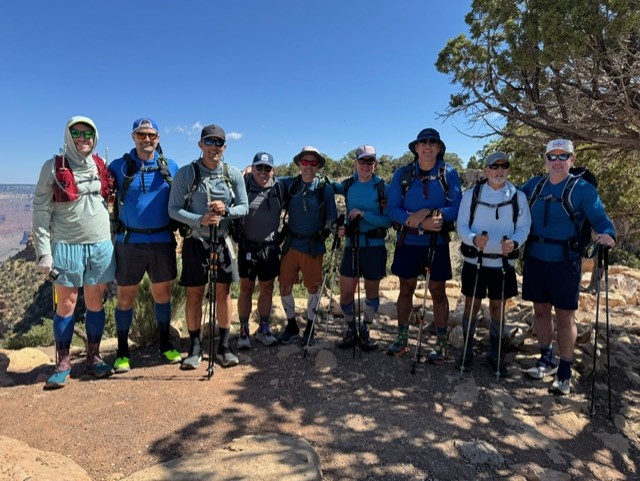80,000 Steps Through the Grand Canyon and What It Taught Me About Resilience by Dr. Barron Bremner, DMOS Orthopedic Surgeon
In December, an old college friend reached out with a question: “Ever thought about hiking Rim to Rim to Rim in the Grand Canyon?” At the time, I hadn’t. But something about the idea stuck.
This spring, after months of training, I found myself at the South Kaibab Trailhead with one old friend and seven new ones. All of them are seasoned endurance athletes who now live in South Carolina. My own training had been solo. I walked miles across the flat Iowa landscape with a 30-pound ruck, did squats and lunges in my garage, and followed a two-month workout plan to make sure I could keep up with the group.
20 Hours. 45 Miles. 11,500 Feet of Climb. More Than 80,000 Steps.
We began our hike at 10 AM, descending the South Kaibab Trail and crossing the Colorado River on the Black Bridge. We passed through Phantom Ranch, moved through the “hot box,” and then climbed the North Kaibab Trail. We reached the North Rim around 9 PM.
Then the real test began. We added layers, turned on our headlamps, and started the steep descent back down the North Rim in the dark. Moths and bats swarmed us. At Manzanita, we paused for water, a cup of soup, and some coffee. Then we continued, retracing our steps across the canyon floor and back up the South Kaibab Trail. Little scorpions dotted the trail, outlined by our lights. As we climbed, the sky began to lighten and we shared the trail with a mountain goat and a team of burros crossed us. We reached the South Rim just before 6 AM.
What I Took Away From the Canyon
My favorite part of the journey was the full experience of the canyon for 20 straight hours. We could feel the temperature shift with every 1,000 feet of elevation. The canyon changed color and temperature with the sunlight and revealed new layers of rock and terrain. The ecosystems evolved as we moved and the sunrise at the end was unforgettable.
The most difficult part wasn’t the hike itself–it was the training. The hours of preparation in the Iowa cold, walking empty roads with a heavy pack and repeating garage workouts with box steps and burpees. That training is what made the hike possible. It was exhausting and boring, but at the same time rewarding.
The Connection to Orthopedics in Central Iowa
This experience mirrors what we see every day in orthopedics. Our patients face their own difficult terrain, and they walk through pain, fear, and uncertainty with determination and hope. Just like preparing for a canyon trek, recovery after orthopedic surgery takes planning, persistence, and support.
As orthopedic surgeons, our job is to be the guide and the coach. We walk beside our patients as they rebuild their strength and mobility. We help them prepare for their personal summit, whether that’s playing sports again, returning to work, or simply walking without pain.
Hiking the Grand Canyon showed me that real strength is built in the preparation and revealed in the climb. That’s exactly what we do at DMOS Orthopaedic Centers to support our patients every day. We are proud to help Central Iowans rise again after injury or surgery, one step at a time.
Resilience isn’t only found in and trek such as Rim to Rim to Rim. It lives in every patient we serve, every care plan we build, and every story of healing that starts with a single step forward.
*Disclaimer: The content of this blog is for informational purposes only. Please consult your healthcare professional for any medical questions. While we make every effort to ensure the information we share is accurate, we welcome comments, suggestions, or corrections of errors. This blog should not be used in any legal capacity whatsoever, including but not limited to establishing a “standard of care” in legal sense or basis for expert witness testimony. No guarantee is given regarding the accuracy of any statements or opinions made on this blog or website. In no way does listening, reading, emailing, or interacting on social media with our content establish a doctor-patient relationship. This blog is not medical advice. If necessary, please seek treatment immediately.*